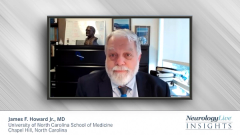
Personalizing gMG Treatment
An expert neurologist comments on the need for generalized myasthenia gravis treatment to be tailored to the patient to alleviate symptoms without significant adverse effects.
James F. Howard Jr, MD: Personalized medicine for myasthenia and other diseases is coming. It’s here, and it will evolve over time. In the past, using broad-spectrum immune suppression, we were happy when the patient was better. “Yes, I can get out of the house. Yes, I can go to work 1 of 5 days, and then I’ve got to rest because I’m exhausted. Yes, I’m willing to tolerate putting on 10 [or] 15 lb because I’m on corticosteroids and have acne all over my face, so I can’t go to the senior prom without being embarrassed. I’m willing to tolerate these [adverse] effects that you give me because I am motorically better. I have strength.” That’s no longer acceptable. Now that we have new choices, now that we have new targeted therapies, our goal as treating clinicians is not simple improvement but no symptoms whatsoever. No symptoms without significant [adverse] effects. Class 1 CTCAE [Common Terminology Criteria for Adverse Events] by definition. And as a result, we have to restructure our thinking as to what is appropriate therapy with our patients. Currently, our new targeted approaches are second-, third-, fourth-line therapeutics, and I would argue that they need to be moved up closer to first line because they work much faster. Why do we need to wait 8 [or] 10 months for a drug to start working when I can have the start of improvement within 1 to 2 weeks? Why do I have to be treated with other therapeutics in addition to what I’m taking, like plasma exchange, like IVIG [intravenous immunoglobulin], with their inherent adverse event potentials, when I can use a newer therapeutic and be stronger much more quickly? And that’s a culture shift that we in society have to make and the payers have to make, the health ministries have to make. So we’re not going to accept being “better” any longer. We have to accept you will have no symptoms and that you will have a positive adverse event profile. It’s with these new therapeutics [that] I think we’re going to achieve that. Not only are the few that we now currently have available, but those that are in the pipeline and understudied at this moment. Mode of administration has always been an issue for some of our newer therapeutics. It’s been intravenous. We now have subcutaneous formulations for some of the FcRns [neonatal Fc receptor agents], either by injection or by infusion rather than intravenous administration. And with a complement inhibitor, we hope to have a subcutaneous formulation within the next several months of this recording. No, not all patients want subcu[taneous]. Some still prefer intravenous. Some see the intravenous sitting in the chair for an hour, an hour and a half, to get their medication as the social event of the week. That’s fine, but there are others who have busy life schedules who need the ability to choose what is best for them. And that is coming, as I already mentioned. We even have oral agents that are in the pipeline that may be beneficial in this same vein of a few [adverse] effects, rapid onset of action, and excellent efficacy. We’re seeing that probably the FcRn inhibitors are going to replace a plasma exchange. Logistically, very difficult. One has to go to specialized store. One has to do that repeatedly over the course of a week or 2 weeks or on a monthly basis. And we can obviate all of that. We can obviate the need for intravenous immunoglobulin infusions for many, perhaps not all, with our current FcRn profiles. So, the strategy and the logistics are changing, as well as the associated complications of the therapeutics that we currently use. And it’s a very exciting time for us in the field.
Transcript is AI-generated and edited for clarity and readability.
Newsletter
Keep your finger on the pulse of neurology—subscribe to NeurologyLive for expert interviews, new data, and breakthrough treatment updates.




























